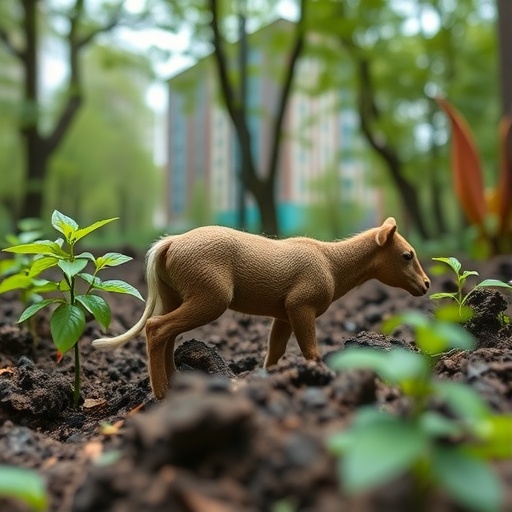Recent studies have unearthed increasingly alarming evidence regarding the interplay between urban environments and the proliferation of zoonotic pathogens. In a groundbreaking paper published in Commun Earth Environ, a team of researchers led by Zhang et al. has shed light on the alarming potential of urban soils to not only harbor but also amplify and homogenize bacterial zoonotic pathogens across various cities in China. This pivotal research underscores the hidden dangers that lie in our seemingly benign urban landscapes.
Urban soils, often overlooked in discussions surrounding infectious diseases, present unique characteristics that can both contribute to and exacerbate the spread of pathogens. The spatial dynamics of urbanization, including changes in land use, waste management practices, and human-animal interactions, have created environments ripe for the proliferation of harmful bacteria. The researchers meticulously analyzed soil samples taken from multiple urban centers, revealing striking commonalities in the types of pathogens present across these diverse ecosystems.
The findings from this extensive research call into question the traditional beliefs about zoonotic pathogens primarily residing in wildlife or rural farming environments. It appears that urban ecosystems, with their complex network of human interactions, waste disposal systems, and diverse animal populations, are incubators for such pathogens. The analysis revealed a worrying number of soil samples teeming with bacteria known for their zoonotic potential, raising concerns about public health implications in metropolitan regions.
One of the most disconcerting aspects of the study is the increased prevalence of certain pathogens that can be easily transmitted from the environment to humans. This suggests that urban residents may be at a higher risk of exposure to diseases that were once considered more narrowly confined to rural areas. The implications for susceptible populations, including young children, the elderly, and immunocompromised individuals, are particularly concerning, as they may face heightened vulnerabilities to infections that originate from the urban soil.
In addition to the shocking data on pathogen prevalence, the study also highlights the phenomenon of homogenization. The researchers found that urban soils across different cities exhibited similarities in the types of bacterial pathogens present. This homogenization suggests that common urban practices and environmental conditions may be fostering similar microbial populations, creating a uniform risk across metropolitan areas. It paints a troubling picture of urban life, where the menace of pathogenic bacteria could persist as cities grow and evolve.
The study’s methodology involved not only the collection of soil samples but also the deployment of advanced microbial genomic techniques to identify and characterize the bacterial populations present. Next-generation sequencing methods provided unprecedented insights into the diversity and abundance of zoonotic pathogens in urban soils. With a focus on high-resolution data, the research team was able to establish correlations between environmental factors and the presence of pathogenic bacteria, offering valuable knowledge for future urban health initiatives.
Furthermore, the researchers cautioned that the proliferation of zoonotic pathogens in urban ecosystems is likely exacerbated by climate change. Changing weather patterns, increased temperatures, and more frequent extreme weather events can significantly alter soil dynamics and influence pathogen survival and transmission. As cities adapt to these changes, understanding the interactions between the urban environment and microbial life becomes increasingly vital.
Public health authorities are urged to reconsider their approaches to controlling zoonotic diseases as a result of this study. The research suggests a need for comprehensive urban sanitation and soil management strategies tailored to mitigate the risks posed by zoonotic pathogens. The integration of microbiological monitoring into urban planning may be essential to safeguard public health, given the intricate relationship between urban infrastructure, soil health, and pathogen dynamics.
By highlighting the dangers lurking in urban soils, this study opens a critical dialogue regarding urban public health policies. Strategies that prioritize the health of urban ecosystems are essential in devising effective interventions against the potential spread of zoonotic diseases. Public awareness campaigns could also play a pivotal role in educating the populace about the risks associated with urban environments and the importance of maintaining safe and healthy outdoor spaces.
As urbanization continues to surge globally, the insights gleaned from this research may resonate far beyond China’s borders. Cities worldwide face similar challenges as they grapple with the consequences of rapid urban growth and increased human-animal interactions. The findings serve as a wake-up call for urban planners and public health officials alike, urging them to integrate environmental health considerations into their strategies and policies.
Ultimately, the revelations put forth by Zhang and his colleagues underscore a need for a multidisciplinary approach to understanding urban health. Collaborative efforts between ecologists, epidemiologists, urban planners, and public health professionals are essential for framing effective responses to the burgeoning threat of zoonotic diseases. Bridging the gap between scientific research and policy-making could lead to innovative solutions that not only address the risks associated with urban soils but also improve the quality of life in cities around the world.
In summary, the groundbreaking research led by Zhang et al. uncovers the profound implications of urban soils in the amplification and dissemination of bacterial zoonotic pathogens across multiple cities in China. As urban populations continue to rise and interconnect, the understanding of these dynamics becomes increasingly crucial in our fight against zoonotic diseases. The findings call for urgent action and thoughtful planning to minimize the risk of pathogen transmission, ensuring that our cities remain safe havens for their inhabitants.
Subject of Research: The role of urban soils in amplifying and homogenizing bacterial zoonotic pathogens in China.
Article Title: Urban soils amplify and homogenize bacterial zoonotic pathogens across multiple Chinese cities.
Article References: Zhang, Y., Xie, A., Robinson, J.M. et al. Urban soils amplify and homogenize bacterial zoonotic pathogens across multiple Chinese cities. Commun Earth Environ 6, 924 (2025). https://doi.org/10.1038/s43247-025-02887-w
Image Credits: AI Generated
DOI: https://doi.org/10.1038/s43247-025-02887-w
Keywords: zoonotic pathogens, urban soils, public health, pathogen amplification, environmental health, microbial genomics, urban ecosystems, climate change, disease transmission.




